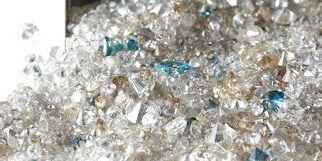The color of a diamond is powerful. Diamonds are cherished for their pure whiteness, and they are also beloved for their rare array of beautiful colors, bright or mellow. The most famous diamond in the world, the Hope Diamond, here in Washington, DC, is an intense blue beauty that brings millions of visitors each year.
The science behind a diamond’s color is a story that took place over millions of years, billions of years ago, and happened on the atomic level. Understanding this amazing science can give you appreciation for the rarity and uniqueness of what makes each diamond and its individual color so special.
The structure of a diamond
Diamonds, scientifically speaking, are unique in many ways. Their chemical structure of pure (or almost-pure) carbon allows the atoms to connect in a super-strong cubic structure through covalent bonds. Unlike graphite, used for pencil led, which is also pure carbon but slippery and dull in color, a diamond’s atoms arrange in a 3D grid where the electrons (the subatomic particles that allow it to hook up to other atoms) are all connected to other carbon atoms in a cubic form, so with no “free” electrons, it’s solidly built down to the atomic level. This structure gives a diamond its strength and clarity.

A diamond forms a solid 3D network, making it a strong crystal, hard and transparent.

Graphite, also pure carbon, forms as thin sheets weakly layered on top of each other, making it slippery and dark.
Purity and types determine color
If you’ve ever shopped for a diamond, however, you know that not all diamonds are free from impurities. Most diamonds have some impurity, from a slight tinge of beige to a desirable vibrant color. A diamond’s color can be the result of a trace element or a change to the structural integrity of the stone. Diamonds are categorized into two types based on the presence or absence of trace elements.
Most diamonds have trace amounts of nitrogen within the carbon structure. Any diamond with nitrogen is considered Type I. Type I is subdivided into two categories. Type Ia are colorless to slightly colored diamonds, the type you would find on the D to Z color scale with slight yellowish or beige undertones due to the clusters of nitrogen atoms within the carbon structure. Type Ib diamonds have a more rare arrangement of nitrogen that causes a bright yellow color to occur; isolated Nitrogen atoms are surrounded by carbon atoms in Type Ib, causing blue light to be absorbed and only yellow light to be reflected. Type Ib diamonds are vibrantly yellow (“canary”) diamonds.
Type II diamonds have no trace nitrogen. Type II is also subdivided. Type IIa has neither nitrogen (which causes yellow) or boron. These are the most chemically pure diamonds and also the most rare. Most Type IIa diamonds are almost always colorless, but they can also be light brown or pink (more about this later). Type IIb has boron impurities which cause blue and gray colors. Less than 0.01% of diamonds are Type IIb, making them extremely rare. The Hope Diamond is a Type IIb.
Other colors can be caused by trace elements like hydrogen, which causes blue or violet tones, mostly found in type Ia.
Structure also determines color
Diamond color can also be determined by what’s called a plastic deformation, which commonly causes brown, pink, and even the rare red diamonds.

When stress is applied to the structure of a diamond (think of the enormous atmospheric stresses that can occur as a mineral is being formed for millions of years under the surface of the earth), even the strong cubic structure of a diamond can buckle under pressure.

This stress can cause the atoms to dislocate and realign.

The new structure affects the way light is absorbed, creating optical effects of reddish, pinkish, brownish colors. (Charts from https://www.debeersgroupinstitute.com/)
Sometimes, radiation from nearby radioactive material even knocks a carbon molecule out of place, causing a void which similarly alters the way light is absorbed, making the diamond green.

Why we love this science
Each of these atomic-level changes that happened over billions of years as diamonds form has a big impact on their appearance and value. Labs like GIA can use special tools to determine a diamond’s type. Collectors are captivated by the most rare occurrences, so those “deformations” and “impurities” can make a stone more valuable than one formed in perfection.
We love the science behind the most romantic stone. Diamonds are valued in the same way we admire and respect the people we love; we cherish what makes our loved ones unique, not what makes them like everyone else. We might fall in love with the freckles across our significant other’s nose, or their strength under pressure, or their musical laugh, or the crooked smile that lights up their face; we love diamonds in the same way, because they are each unique, and their one-of-a-kind combination of “flaws” and strengths make them even more beautiful.
Have we piqued your interest in choosing a diamond that celebrates rarity and color? Stop by Secrete Fine Jewelry in Washington, DC, or Bethesda, Maryland, to see some gorgeous examples of the miracle of science and to start creating a custom-designed piece of jewelry to showcase it in your own unique way.







